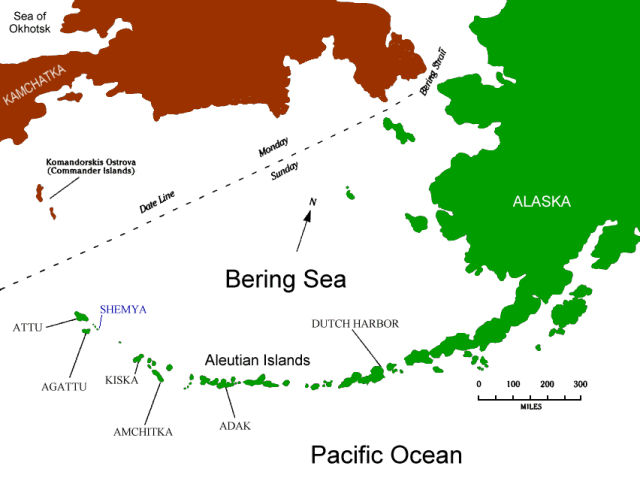
Today is very different. Yesterday at the breakfast table I looked out our kitchen window to see songbirds in the low spring sunlight filtering through the evergreens. Today I see gray, brown, and a barren landscape. I’m on Adak Island for the start of our three-week, self-supported sea kayak expedition. It’s late May and we are about to explore the Andreanof Island group in the western Aleutian Islands chain of Alaska, 1,200 miles west of Anchorage. It is one of the most remote and harsh locations in the United States.
The journey to this intriguing place started about six months ago (but the planning began long before that) when the kayaks were packed and shipped from Seattle to Dutch Harbor, Alaska, for an uncertain onward voyage to Adak. We were extremely lucky to find a small barge on which our kayaks hitchhiked a ride, literally being strapped to a crane destined for the “Adak small-boat harbor improvement project.” Our primary goal was to paddle west from Adak to Tanaga Island and explore the coastline of Kanaga Island with its impressive volcano along the way.
To our knowledge, we are the first “modern” kayakers to travel this windswept region. In fact, Adak Island is commonly known as the birthplace of the winds, and legend says it is also the birthplace of the ancient Aleut who inhabited this island archipelago until the U.S. government “relocated” them during World War II. The Aleut lived off the sea and used sophisticated skin-on-frame craft for subsistence fishing and hunting of seal, sea lion and whale. These peoples were the inventors of kayaking and plied these waters for millennia before westerners arrived. As a kayaker I wanted to connect in some way to this ancient lifestyle and understand firsthand how they managed and lived.
Our trip was not unlike Vitus Bering’s 1741 “Voyage of Discovery” that sailed in two ships, the St. Peter and St. Paul, but with key differences. His commission was to claim the land east of Russia for the Imperial Court. We arrived from the west via air and paddled in four kayaks to connect with the land, its fauna, flora and culture and to discover its rich and volatile history.
About the presenter
Rob Avery has been paddling for more than 40 years and loves to share his passion for the sea and the natural environment. He is an active canoe and kayak British Canoe Union coach, an American Canoe Association Level-5 instructor, a Wilderness First Responder and a Leave-No-Trace Trainer. Avery has paddled extensively in the UK (his home country), USA, Baja California, British Columbia and Alaska, including Glacier Bay, Kodiak Island, the Kenai Peninsula and the Aleutian Islands. He is at home on sheltered bays observing the fauna and flora or paddling in the teeth of storms. Avery owns and operates Kayak Kraft on Bainbridge Island.
This week’s presentation:
Aleutian Images: A Sea Kayaking Expedition
through the Andreanof Islands
By: Rob Avery
When: 7 p.m., Thursday, March 3
Where: Sequim High School cafeteria, 601 N. Sequim Ave.
Admission: $5 at the door (youths 18 and younger are free)
Next week’s presentation:
A piedi, con l’autobus, con il treno: Study Abroad in Florence, Italy, by Kate Reavey and family








No comments:
Post a Comment